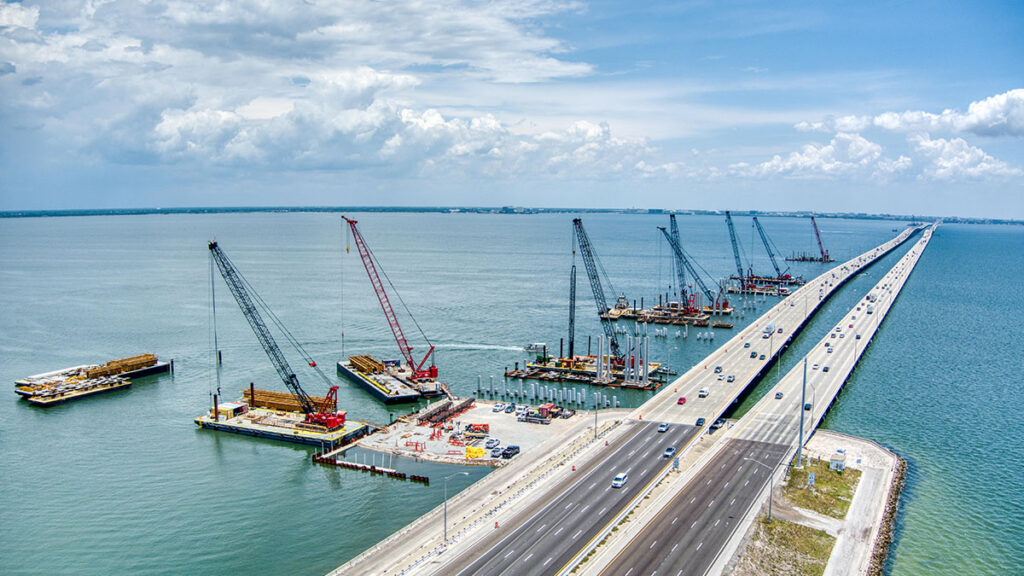The Howard Frankland Bridge, often referred to as the “Gateway to Tampa Bay,” is an iconic part of Florida’s transportation infrastructure. Stretching over the blue waters of Tampa Bay, this bridge not only connects Tampa and St. Petersburg, but also plays a pivotal role in the economic and social growth of the region. From its early beginnings to the ongoing expansion, the Howard Frankland Bridge has remained a vital artery for residents, businesses, and tourists alike.
The Early History of the Howard Frankland Bridge
Vision for Connectivity
The idea of a bridge spanning Tampa Bay dates back to the mid-20th century when regional growth prompted the need for better transportation links. Prior to the construction of the Howard Frankland Bridge, commuters between Tampa and St. Petersburg relied on the Gandy Bridge and the Courtney Campbell Causeway, which were often congested and lengthy.
Construction and Opening (1959)
The original Howard Frankland Bridge opened in 1959, named after Howard Frankland, a prominent businessman who advocated for its construction. At the time, it was a four-lane bridge, designed to accommodate the increasing number of vehicles traveling across the bay. While it initially faced criticism for traffic bottlenecks, it became a lifeline for the growing communities of the region, reducing travel time between Tampa and St. Petersburg by nearly 40 minutes.
The Importance of the Bridge to Florida’s Growth
Economic Impact
Florida’s rapid development in the latter half of the 20th century was fueled by infrastructure projects like the Howard Frankland Bridge. As the state’s population exploded, the bridge facilitated:
- Commuter traffic for workers in both Tampa and St. Petersburg.
- Tourism, as visitors found it easier to travel between the Gulf Coast’s most popular cities.
- Business expansion, allowing for better connectivity and trade between the economic hubs of the region.
Boosting Real Estate and Development
With improved access across Tampa Bay, real estate development on both sides of the bridge skyrocketed. Neighborhoods, business districts, and recreational facilities were built at an unprecedented rate, with areas like Carillon Park and Westshore benefiting from the bridge’s proximity.
The Need for Expansion: Addressing Traffic Challenges
Growing Traffic Demands
As the region continued to grow, it became clear that the original four-lane bridge could no longer support the increasing traffic volume. The bridge, which had originally been designed to carry about 30,000 vehicles per day, began to experience upwards of 150,000 vehicles daily by the 1980s. This created significant congestion, long travel times, and safety concerns.
The 1990 Expansion
In response to these issues, a second span was constructed in 1990 to alleviate congestion. This new span featured four additional lanes, making the Howard Frankland Bridge an eight-lane structure. This expansion significantly reduced bottlenecks and improved traffic flow, providing relief to thousands of daily commuters.
The Current Expansion Project
A Vision for the Future
Florida’s population continues to rise, and with it, so does the need for further infrastructure upgrades. In recent years, the state has embarked on a major expansion of the Howard Frankland Bridge to ensure it can meet the demands of the future.
Key Features of the Ongoing Expansion (2020-2026)
The new expansion project, which began in 2020 and is expected to be completed by 2026, aims to future-proof the bridge for generations to come. This project includes:
- A new northbound span, which will feature four general-purpose lanes and two express lanes, dedicated to easing traffic congestion.
- Bicycle and pedestrian paths, adding a multi-use trail for non-motorized travelers.
- Enhanced safety features, including better lighting, guardrails, and modernized roadways to prevent accidents.
Environmental and Social Considerations
Preserving Tampa Bay’s Ecosystem
While expanding the Howard Frankland Bridge, Florida’s Department of Transportation (FDOT) has prioritized minimizing environmental impact. Measures include:
- Reducing water pollution by using environmentally friendly construction practices.
- Protecting marine habitats, especially during the bridge-building process.
Connecting Communities
The Howard Frankland Bridge is more than just a road; it’s a symbol of connectivity for Tampa Bay’s residents. The latest expansion focuses on not only improving traffic but also creating a bridge that connects communities. The addition of pedestrian and bike paths signifies a shift toward multi-modal transportation, ensuring all residents can cross the bay safely, whether on foot, by bike, or by car.
The Role of the Bridge in Florida’s Economic Future
Supporting Regional Growth
The expanded Howard Frankland Bridge is a critical component in supporting the continued growth of the Tampa Bay region.
Enhancing Trade and Commerce
The bridge is part of a larger network that supports trade in the region. Its expansion is expected to improve logistics for businesses and help support Florida’s status as a major player in national and international trade.
Conclusion:
From its humble beginnings in 1959 to its current status as a vital piece of Florida’s infrastructure, the Howard Frankland Bridge has played a key role in connecting the people, economies, and communities of Tampa Bay. As the latest expansion continues to take shape, the bridge is not just a testament to the state’s growth, but also to its ability to adapt to the needs of a dynamic and evolving population. Whether you’re commuting to work, traveling for leisure, or simply enjoying a bike ride across Tampa Bay, the Howard Frankland Bridge remains an essential part of the Florida experience.







